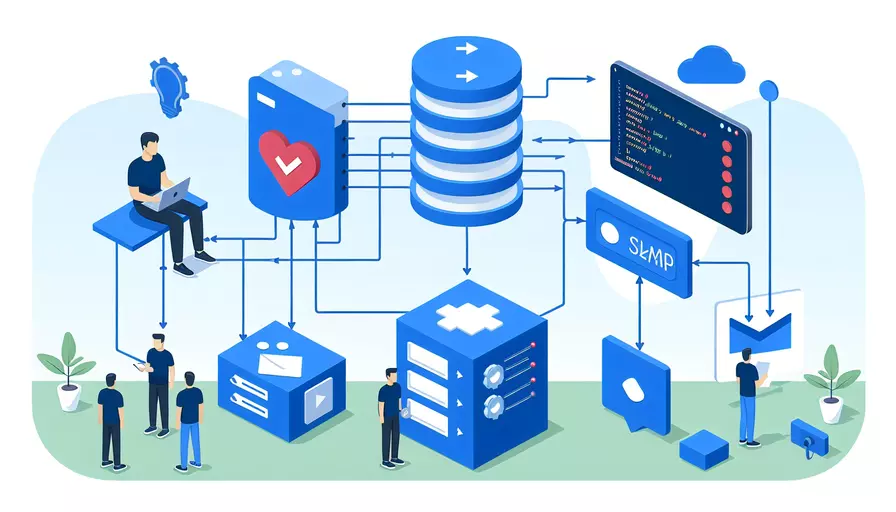
在Vue组件中,数据传递主要通过1、Props、2、事件和3、Vuex等方式实现。每种方法都有其独特的应用场景和优缺点,选择哪种方法取决于具体需求和项目的复杂性。
一、通过Props传递数据
Props是Vue中用于父组件向子组件传递数据的一种机制。通过在子组件中定义props属性,父组件可以将数据通过props传递给子组件。
步骤:
- 定义子组件中的props:在子组件中使用
props属性来声明接收的数据。 - 父组件传递数据:在父组件中通过绑定属性的方式将数据传递给子组件。
示例:
// 子组件 ChildComponent.vue
<template>
<div>
<p>{{ message }}</p>
</div>
</template>
<script>
export default {
props: {
message: String
}
}
</script>
// 父组件 ParentComponent.vue
<template>
<div>
<ChildComponent :message="parentMessage"/>
</div>
</template>
<script>
import ChildComponent from './ChildComponent.vue'
export default {
components: {
ChildComponent
},
data() {
return {
parentMessage: 'Hello from Parent'
}
}
}
</script>
背景信息:
- 优点:简单易用,适合父子组件之间的简单数据传递。
- 缺点:只能实现单向数据流,即父组件可以传递数据给子组件,但子组件不能直接修改父组件的数据。
二、通过事件传递数据
在Vue中,子组件可以通过触发事件来向父组件传递数据。父组件通过监听这些事件来获取子组件传递的数据。
步骤:
- 子组件触发事件:在子组件中使用
$emit方法触发事件并传递数据。 - 父组件监听事件:在父组件中使用
v-on或@符号来监听子组件触发的事件,并接收数据。
示例:
// 子组件 ChildComponent.vue
<template>
<div>
<button @click="sendData">Send Data to Parent</button>
</div>
</template>
<script>
export default {
methods: {
sendData() {
this.$emit('data-sent', 'Hello from Child')
}
}
}
</script>
// 父组件 ParentComponent.vue
<template>
<div>
<ChildComponent @data-sent="receiveData"/>
</div>
</template>
<script>
import ChildComponent from './ChildComponent.vue'
export default {
components: {
ChildComponent
},
methods: {
receiveData(data) {
console.log(data) // Outputs: Hello from Child
}
}
}
</script>
背景信息:
- 优点:实现父子组件之间的双向通信,灵活性高。
- 缺点:在大型项目中,事件管理可能变得复杂,增加维护难度。
三、通过Vuex传递数据
Vuex是Vue.js的状态管理模式,适用于中大型应用中组件之间的复杂数据共享和管理。Vuex提供了一个集中式的存储库,所有组件的数据状态都存储在这个仓库中。
步骤:
- 安装Vuex:通过npm或yarn安装Vuex。
- 创建Store:定义state、mutations、actions和getters。
- 在组件中访问和修改Store:通过
mapState、mapGetters、mapActions和mapMutations辅助函数访问和修改store中的数据。
示例:
// store.js
import Vue from 'vue'
import Vuex from 'vuex'
Vue.use(Vuex)
export default new Vuex.Store({
state: {
message: 'Hello from Vuex'
},
mutations: {
setMessage(state, newMessage) {
state.message = newMessage
}
},
actions: {
updateMessage({ commit }, newMessage) {
commit('setMessage', newMessage)
}
},
getters: {
getMessage: state => state.message
}
})
// 组件 Component.vue
<template>
<div>
<p>{{ message }}</p>
<button @click="changeMessage">Change Message</button>
</div>
</template>
<script>
import { mapState, mapActions } from 'vuex'
export default {
computed: {
...mapState(['message'])
},
methods: {
...mapActions(['updateMessage']),
changeMessage() {
this.updateMessage('Hello from Component')
}
}
}
</script>
背景信息:
- 优点:适合管理复杂的应用状态,提供了统一的状态管理和调试工具。
- 缺点:学习成本较高,适用于大型项目,不适合简单的应用。
四、通过Provide/Inject传递数据
Provide/Inject是Vue提供的一种跨层级数据传递方法,适用于需要在祖先组件和后代组件之间共享数据的场景。
步骤:
- 祖先组件提供数据:使用
provide选项提供数据。 - 后代组件注入数据:使用
inject选项接收数据。
示例:
// 祖先组件 AncestorComponent.vue
<template>
<div>
<DescendantComponent/>
</div>
</template>
<script>
import DescendantComponent from './DescendantComponent.vue'
export default {
components: {
DescendantComponent
},
provide() {
return {
message: 'Hello from Ancestor'
}
}
}
</script>
// 后代组件 DescendantComponent.vue
<template>
<div>
<p>{{ message }}</p>
</div>
</template>
<script>
export default {
inject: ['message']
}
</script>
背景信息:
- 优点:适合跨层级组件数据传递,避免了逐层传递数据的麻烦。
- 缺点:使用不当可能导致数据流向不清晰,调试困难。
总结
在Vue组件中传递数据的方式主要有Props、事件、Vuex和Provide/Inject。每种方式都有其独特的应用场景和优缺点:
- Props:适用于父子组件之间的简单数据传递。
- 事件:适用于父子组件之间的双向通信。
- Vuex:适用于中大型应用中复杂状态管理。
- Provide/Inject:适用于跨层级组件数据传递。
根据项目的具体需求和复杂性,选择合适的方法来传递数据,以实现最佳的代码可维护性和性能。如果项目较小,使用Props和事件即可满足需求;如果项目较大且状态管理复杂,建议使用Vuex。Provide/Inject适合在需要跨层级数据传递时使用,但需谨慎使用以避免数据流向不清晰的问题。
相关问答FAQs:
1. 如何在父组件向子组件传递数据?
在Vue中,父组件向子组件传递数据可以通过props属性来实现。在父组件中定义一个props对象,包含要传递给子组件的数据。然后在子组件中通过props属性接收父组件传递的数据。可以通过v-bind指令将父组件的数据绑定到子组件的props属性上。
例如,在父组件中定义一个名为message的props对象:
<template>
<div>
<child-component :message="message"></child-component>
</div>
</template>
<script>
import ChildComponent from './ChildComponent.vue';
export default {
components: {
ChildComponent
},
data() {
return {
message: 'Hello, World!'
};
}
};
</script>
在子组件中通过props属性接收父组件传递的数据:
<template>
<div>
<p>{{ message }}</p>
</div>
</template>
<script>
export default {
props: ['message']
};
</script>
2. 如何在子组件向父组件传递数据?
在Vue中,子组件向父组件传递数据可以通过自定义事件来实现。在子组件中通过$emit方法触发一个自定义事件,并传递要传递给父组件的数据。在父组件中通过v-on指令监听子组件触发的自定义事件,并在事件处理函数中接收子组件传递的数据。
例如,在子组件中触发一个名为update的自定义事件,并传递一个名为data的数据:
<template>
<div>
<button @click="updateParent">Update Parent</button>
</div>
</template>
<script>
export default {
methods: {
updateParent() {
this.$emit('update', 'Data from child component');
}
}
};
</script>
在父组件中通过v-on指令监听子组件触发的自定义事件,并在事件处理函数中接收子组件传递的数据:
<template>
<div>
<child-component @update="handleUpdate"></child-component>
</div>
</template>
<script>
import ChildComponent from './ChildComponent.vue';
export default {
components: {
ChildComponent
},
methods: {
handleUpdate(data) {
console.log(data); // 输出:Data from child component
}
}
};
</script>
3. 如何在兄弟组件之间传递数据?
在Vue中,兄弟组件之间传递数据可以通过一个共享的父组件来实现。父组件中可以定义一个数据对象,并将它作为props属性分别传递给两个兄弟组件。兄弟组件可以通过props属性接收父组件传递的数据,并可以通过$emit方法触发自定义事件将数据传递给父组件。
例如,有两个兄弟组件A和B,它们共享一个名为data的数据:
<template>
<div>
<component-a :data="data" @update="handleUpdate"></component-a>
<component-b :data="data"></component-b>
</div>
</template>
<script>
import ComponentA from './ComponentA.vue';
import ComponentB from './ComponentB.vue';
export default {
components: {
ComponentA,
ComponentB
},
data() {
return {
data: ''
};
},
methods: {
handleUpdate(data) {
this.data = data;
}
}
};
</script>
在组件A中通过props属性接收父组件传递的数据,并通过$emit方法触发自定义事件将数据传递给父组件:
<template>
<div>
<input type="text" v-model="inputData">
<button @click="updateParent">Update Parent</button>
</div>
</template>
<script>
export default {
props: ['data'],
data() {
return {
inputData: ''
};
},
methods: {
updateParent() {
this.$emit('update', this.inputData);
}
}
};
</script>
在组件B中通过props属性接收父组件传递的数据:
<template>
<div>
<p>{{ data }}</p>
</div>
</template>
<script>
export default {
props: ['data']
};
</script>
通过共享的父组件,组件A可以将输入的数据传递给组件B,并更新父组件中的data数据。
文章标题:vue组件如何传递数据,发布者:不及物动词,转载请注明出处:https://worktile.com/kb/p/3615402

 微信扫一扫
微信扫一扫  支付宝扫一扫
支付宝扫一扫 